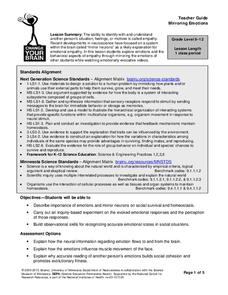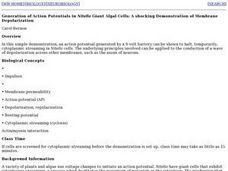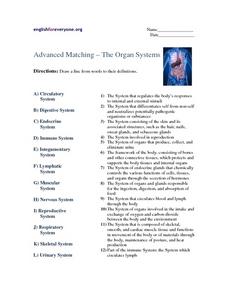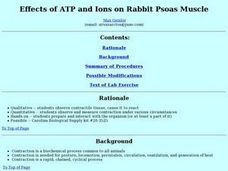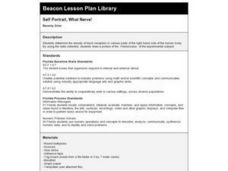Curated OER
PARAMECIUM RESPONSES TO STIMIULI
Students design the test they use to examine, how the paramecium move, feed, and react to different types of stimuli such as a drop of vinegar. They conduct a lab experiment using a microscope.
Curated OER
Ego Trip- Exploring the Inner Workings of the Human Body
Students gain an understanding of how systems and organs in the human body work. They create their own fictional account of a trip through the human body, and describe one response the body makes to stimuli.
Curated OER
The Brain’s Inner Workings
Do you want to learn about how you learn? Help pupils become the best learners they can be by teaching them how their brain works. The resources available include videos about brain structure and a study guide full of activities that...
University of Minnesota
Virtual Neurons
It's electric! Young anatomists use Virtual Neurons software to build, control, and analyze complex nerve circuits within the body. Colorful and packed with content, class members enjoy interacting with the nervous system...
University of Minnesota
Mirroring Emotions
Do you ever give your class the "teacher look"? Without saying a word, they become silent and engaged (hopefully). How do they know what you're thinking? Explore the concept of nonverbal communication and how it relates to our...
Nuffield Foundation
Interpreting an Investigation of Plant Hormones
How important is the tip of a new shoot on a growing plant? Individuals learn about the results of experiments on shoot tips and must interpret them. They apply previous learning and connect complex ideas through advanced analysis.
Curated OER
How Organisms Respond to Changes in their Environment
Students observe the reaction of living cells to mechanical and chemical stimuli by introducing different stimuli to an organism under a microscope and recording the response.
Curated OER
Generation of Action Potentials in Nitella Giant Algal Cells
Students observe cytoplasmic streaming in Nitella cells. They examine the conduction of a wave of depolarization across other membranes, such as the axons of neurons. Students predict the effects of sending a small electric current...
Curated OER
Plant Responses
In this plant response worksheet, students will explore the different responses plants have to different stimuli, including light and gravity. Students will complete 7 multiple choice questions and 3 fill in the blank questions.
Curated OER
What is Life? Demonstrations & Discussion
Display seven items for your biologists to consider. Are they living or non-living? How can you tell? This is a simple outline of what you can display and questions that can be discussed as this topic is explored. One way to use this...
Curated OER
Advanced Matching - The Organ Systems
What's the difference between the digestive system and the endocrine system? Explore 12 body systems in this anatomy matching instructional activity, for which learners find descriptions corresponding to anatomical terminology. Some of...
Curated OER
Investigating the Regulation of Leukocyte Adhesion Through Extracellular Matrices
Students examine the relationship between leukocyte adhesion and migration in response to chemoattractants. They discuss sterile techniques, observe a demonstration using mock cell culture, and develop a procedure for studying the...
Curated OER
Plants In Space
In this biology worksheet, students grow corn plants in growth pouches as the control group in an experiment on plant growth in microgravity. Then they analyze any differences that occur between Earth-grown and space-grown corn plants.
Curated OER
DNA Chips
High schoolers discover what they need to know about DNA chips. They extend this knowledge to analyze gene expression data to diagnose two kinds of leukemia.
Curated OER
DNA Chips
Students explore issues surrounding DNA microarray technology. They focus on a single area of biomedical research to help them explain how science, people, ethics, and history all fit together. They analyze gene-expression data.
Curated OER
Effects of ATP and Ions on Rabbit Psoas Muscle
Students prepare single strands of muscle cell. They microscopically examine muscle cells and identify bands of darker and lighter proteins. They predict, observe, describe and quantify the effects of ions and ATP.
Curated OER
Revised “Understanding Nutrition” Activity
Students evaluate their current food choices. In this health science lesson, students test different drinks to rate the amount of Vitamin C content. They discuss results in class.
Curated OER
Self Portrait, What Nerve!
Learners conduct an experiment to determine the distance between touch receptor fields in parts of the right-hand side of the body. They enter data into the data table.
Khan Academy
Khan Academy: Are Viruses Dead or Alive?
Are viruses alive or dead? How do we determine whether something is alive? Let's compare viruses to the 7 criteria researchers have set to determine if something is alive.
BiologyWise
Biology Wise: The 7 Unmistakable Characteristics of Life
Describes the seven characteristics that define life - cells, homeostasis, heredity, use of energy, reproduction, response to environmental stimuli, and evolution and adaptation.
eSchool Today
E School Today: Your Revision Notes on the Characteristics of Living Things
Discusses the five characteristics that living things have and nonliving things do not.
PBS
Pbs Teachers: Changing Your Mind: Increasing Brainpower
Investigate the brain and it's connections - the number of possible routes along which a brain message might travel - by solving and creating geometric progressions. Conduct an experiment to learn about stimulus and response.




